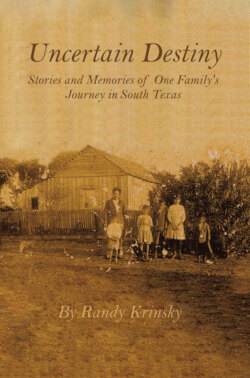Читать книгу Uncertain Destiny - Randy Krinsky - Страница 9
На сайте Литреса книга снята с продажи.
ОглавлениеEarly Life in San Antonio
Before the arrival of the Isleños, there were roughly forty-five soldiers stationed in the Presidio de San Antonio de Béxar. About four families lived in the surrounding area, and an additional nine soldiers rotated among the area missions. The total civilian population for the unincorporated region was about two hundred people. The arrival of the Isleños added a further fifty-six persons to that community.
Once the Isleños arrived, Captain Juan Antonio Pérez de Almazán had to establish a way to keep civil order aside from the military community that already existed at the nearby presidio. On July 20, 1731, approximately five months after the Isleños’ arrival, Captain Almazán formed the first cabildo, or city council. He appointed the council’s first members, selecting the eldest and most respected of the Isleños, Don Juan Leal Goraz, as the first regidor, or councilman. This appointment made sense as Don Juan had been the leader of the Isleños throughout their journey from the Canary Islands. Captain Almazán selected the rest of the council: Juan Curbelo, second regidor; Antonio Santos, third regidor; Salvador Rodríguez, fourth regidor; Manuel de Niz, fifth regidor, and Juan Leal Jr., sixth regidor. Each regidor would be responsible for overseeing a different aspect of villa business. Curbelo would be in charge of the new jail to be constructed. Santos was responsible for official weights and measures. Rodríguez would supervise all warehouses and public buildings. Manuel de Niz would be responsible for any unclaimed property, while Juan Leal Jr. would take over no other extra duties other than being a voting member of the cabildo.
In addition to those regidors, Captain Almazán needed others to assist in civic oversight and law enforcement for the now-growing community. He appointed Vicente Álvarez Travieso to be the first alguacil mayor, or sheriff. He also appointed Antonio Rodríguez to the position of mayordomo de los propios, or public lands administrator. Back in the Canary Islands, Antonio Rodríguez was a skilled irrigator. Here he would be responsible again for the irrigation system as well as the overall cleanliness of the villa. The position would also be responsible for collecting debts and revenues, basically acting as city attorney. Captain Almazán, under the authority of the governor, made these all life appointments.
On August 1, 1731, Captain Almazán administered the oath of office to each of the newly appointed villa officials. Each swore to be loyal and to carry out the responsibilities of their respective offices faithfully. The cabildo’s first task was to elect two alcades, mayors, amounting to the first civil election in Texas. The eight voting members unanimously voted Don Juan Leal Goraz to be the first alcalde. A second ballot was called, and Don Salvador Rodríguez was elected the second alcalde.
The next order of business was what to call their new villa. The cabildo debated back and forth, but the whole conversation was moot when Captain Almazán notified them that the viceroy had already chosen a name: San Fernando de Béxar (or Bexar), so named to honor the king’s son, Crown Prince Fernando. So it was done. The first organized civil government in Texas was born.36
Now that the Isleños were here, they had to integrate with those that were already living in the area. One way to foster community and bring people together is through food. According to some historians, the food of the Isleños heavily influenced what we now know nationally as Tex-Mex. It was the Isleños that introduced cilantro, cumin, and possibly even some chili peppers into Texas colonial cooking. When combined with local ingredients like beef, pecans, and pinto beans, with the added smoked flavor of mesquite wood-fueled cooking, Tex-Mex arose.
The Isleños brought with them recipes for mojo sauce, a must-have condiment for most dishes. Mojo sauce came in two varieties, verde and rojo. Mojo verde, or Canarian green sauce, is a delicious cilantro-infused sauce, thick in consistency, not creamy, with garlic, oil, and cumin. Mojo rojo is red and made with oil, vinegar, chili, garlic, cumin, and paprika. Today, you can find many different versions of this sauce with no two recipes alike. Sound familiar? These are directly related to the salsa verde and salsa rojo that just about every Tex-Mex restaurant brings out to your table with chips. The sauces have made their way around the world but originated in the Canary Islands.
Additionally, the Isleños loved cheese. With no experience as ranchers and practically no cattle in the Canary Islands, Canarian queso, or cheese, was primarily made from goats. Also known as queso de cabra, this creamy goat cheese can be enjoyed alone or with a little added garlic and served with bread as almogrote, similar to Tex-Mex queso and chips.
There’s also a delicious rabbit stew with tomatoes, called conejo al salmorejo, or there’s sancocho, another meat-and-vegetable stew, sometimes made with boiled sea bass and served with potatoes and mojo sauce. Any way you serve it, Isleños brought with them a cuisine that has endured and evolved, adding Native American influences, and traces of it all can still be found in authentic Tex-Mex.37
Plazas of San Antonio, circa 1778 (undated compilation by John Ogden Leal, UTSA Special Libraries Collection).38
Close-up of the San Antonio Plaza, 1778: The homestead of Salvador Rodriguez is on the north side of the plaza on what is now Commerce Street.
The home of Juan Leal Goraz is on the opposite side, on what is
now Dolorosa Street. Both are shown to be east of Soledad,
near the San Fernando Cathedral.39
